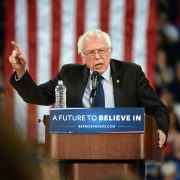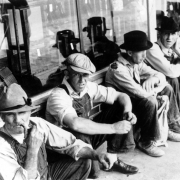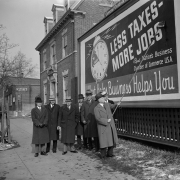After several years of economic unrest, in 1935 the U.S. economy seemed as though it might be in recovery. And in the wake of the Supreme Court striking down both the Agricultural Adjustment Act and the National Recovery Act, the Great Depression seemed like it may be coming to an end. In fact, by 1935 the number of unemployed had dropped to 9.5 million. By the next year, it was down to 7.6 million. But this trend would not continue.
Even though the economy had started improving, the government had still not learned its lesson about intervening in the economy. While the Supreme Court had justly ruled that the AAA and the NRA were unconstitutional, Supreme Court Justices had upheld the constitutionality of the Wagner Act. Serving as a “Magna Carta” to labor unions, union leaders now had new powers that were upheld by the highest court.
As explained by Hans Sennholz:
“The law revolutionized American Labor relations. It took disputes out of the courts of law and brought them under a newly created Federal agency, the National Labor Relations Board, which became prosecutor, judge, and jury, all in one. Labor union sympathizers on the Board further perverted this law, which already afforded legal immunities and privileges to labor unions. The U.S. thereby abandoned a great achievement of Western civilization, equality under the law.”
And in 1937, right after the Wagner Act was upheld, The Dow Jones Industrial Average tanked once more and unemployment rates rose in response.
The Wagner Act
Prior to the passing of the Wagner Act, workers were free to either join a labor union or abstain from joining altogether. But after its passage in 1935, this freedom of association was done away with.
Under the Wagner Act, when a majority of workers in a given industry chose to unionize, all workers would be forced to either join or at minimum pay the union dues. The government’s logic assumed that since all workers would benefit from union leaders collective bargaining on their behalf, all workers should have to contribute. But not all workers wanted someone collectively bargaining on their behalf. And to bargain collectively entirely negates the role individual incentives play in employment.
Instead of each employee and employer working together to assess skill sets and value creation and determine an acceptable wage, one union leader would be doing this on behalf of all employees. If you were not as productive as your coworkers, this might be a huge relief to you, but for hard workers, this meant being judged as a group and not on their individual merit. But the affront to individualism did not end there.
If a majority of workers had decided they wanted to unionize under one particular collective bargaining agent, the topic never came up for debate again. This is because, under the Wagner Act, it didn’t need to.
As Tom Woods explains:
“Once officially designated by a majority of workers as the exclusive bargaining agent for all workers, the union is never required to stand for re-election. Even after all the workers who originally voted for the union have died or retired, the union is simply assumed to have the support of a majority of workers. The new slate of workers has no say in the matter at all.”
But in addition to forcing employees to join unions, the Wagner Act also mandated that employers must play ball with the unions, or else face the consequences with the National Labor Relations Board. In fact, if any employers were concerned with the presence and power these labor unions were having and chose to voice these concerns to any of their employees, they could be reported for “unfair labor practices.” If this sounds like a violation of the First Amendment rights to free speech, that is because it absolutely is.
It is no surprise then that the Supreme Court’s upholding of the Wagner Act made many labor unions feel invincible. All any union leader, or member, had to do was threaten to strike and they could manipulate employers into caving to every one of their whims. But their coercive tactics didn’t end at mere threats. In fact, the Wagner Act ushered in an era of militancy on behalf of unions. Violent strikes and demonstrations occurred regularly throughout this period. And legally, there was little anyone could do about it.
As Woods writes:
“Furthermore, the Wagner Act gave labor unions a degree of legal insulation afforded to no other group in society. The Act made labor unions immune to claims of vicarious responsibility. In plain English, that means that labor unions are not legally responsible for any violence their members might commit, even if union officials themselves order the violence.”
And as the great F.A. Hayek once wrote, “We have now reached a state where [unions] have become uniquely privileged institutions to which the general rules of law do not apply.” And while the Wagner Act took a toll on the concept of private sector employment, its economic consequences were disastrous and served to prolong the Great Depression even longer.
Impacts on the Economy
Explaining how the Wagner Act impacted the economy in 1935, The Wall Street Journal states:
“A principal factor in the meltdown that year was the U.S. Supreme Court’s surprise 5-4 decision in early April to uphold the constitutionality of the Wagner Act, which had passed two years earlier. This measure, which is still the basis of our labor relations regime, authorized union officials to seek and obtain the power to act as the “exclusive” (that is, the monopoly) bargaining agent over all the front-line employees, including union nonmembers as well as members, in a unionized workplace.”
In the first few months after the Supreme Court’s decision, industrial production fell and with it, employment rates. In fact, the situation grew so dire, employment rates fell back to the 1931 levels when the Great Depression had just begun. But what is particularly interesting is that employment rates fell even as union membership continued to grow.
And with the rise of unions, employers and business owners suddenly became the bad guy. Looking for any excuse to squeeze money from the private sector, the Wagner Act also solidified FDR’s war on the business class. He imposed new stock market restrictions and even taxed retained corporate earning with the “undistributed profits tax.” And as we have already seen, taxing the business owners, who also serve as job creators, harms the entire economy and results in increased rates of unemployment.
But business owners and employers would not get relief from the Wagner Act until the Taft-Hartley Act of 1947 gave each state the authority to pass “right to work” laws that would protect employees from being forced to join labor unions or pay dues.












